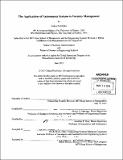The applications of autonomous systems to forestry management
Author(s)
Przybylko, Joshua
DownloadFull printable version (34.17Mb)
Other Contributors
Leaders for Global Operations Program.
Advisor
Steven D. Eppinger and Jonathan P. How.
Terms of use
Metadata
Show full item recordAbstract
Public and private timberland owners continually search for new, cost effective methods to monitor and nurture their timber stand investments. Common management tasks include monitoring tree growth and tree health, estimating timber value and preventing wildfire. Many of these tasks are both manual and costly due to the vast areas and remote locations involved. Forestry experts predict that multi-vehicle autonomous systems may enable new, cost effective methods for performing various forest management tasks[1]. However, it remains unclear how these technologies may be applied, or where to focus development efforts. This research attempts to address this gap in literature, linking state-of-the-art research in forestry management science, robotics and autonomous systems, and product design and development. This thesis begins by reviewing existing forestry management practices and discussing a number of challenges identified through industry interviews and research. Modem product design methods are reviewed, and used to generate ideas for a number of new concept systems. Three design concepts are presented as detailed case studies. The data sets, methods and proposed systems discussed in this thesis may be used to guide future research in forestry management science, and drive further innovation in the emerging field of commercial and civilian autonomous systems. Key words: Forestry Management, Forestry Science, Robotics and Autonomous Systems, Unmanned Aerial Vehicles (UAV), Unmanned Aerial Systems (UAS), Product Design and Development, Light Detection and Ranging (LiDAR)
Description
Thesis (M.B.A.)--Massachusetts Institute of Technology, Sloan School of Management; and, (S.M.)--Massachusetts Institute of Technology, Engineering Systems Division; in conjunction with the Leaders for Global Operations Program at MIT, 2013. Cataloged from PDF version of thesis. Includes bibliographical references (p. 132-137).
Date issued
2013Department
Leaders for Global Operations Program at MIT; Massachusetts Institute of Technology. Engineering Systems Division; Sloan School of ManagementPublisher
Massachusetts Institute of Technology
Keywords
Sloan School of Management., Engineering Systems Division., Leaders for Global Operations Program.